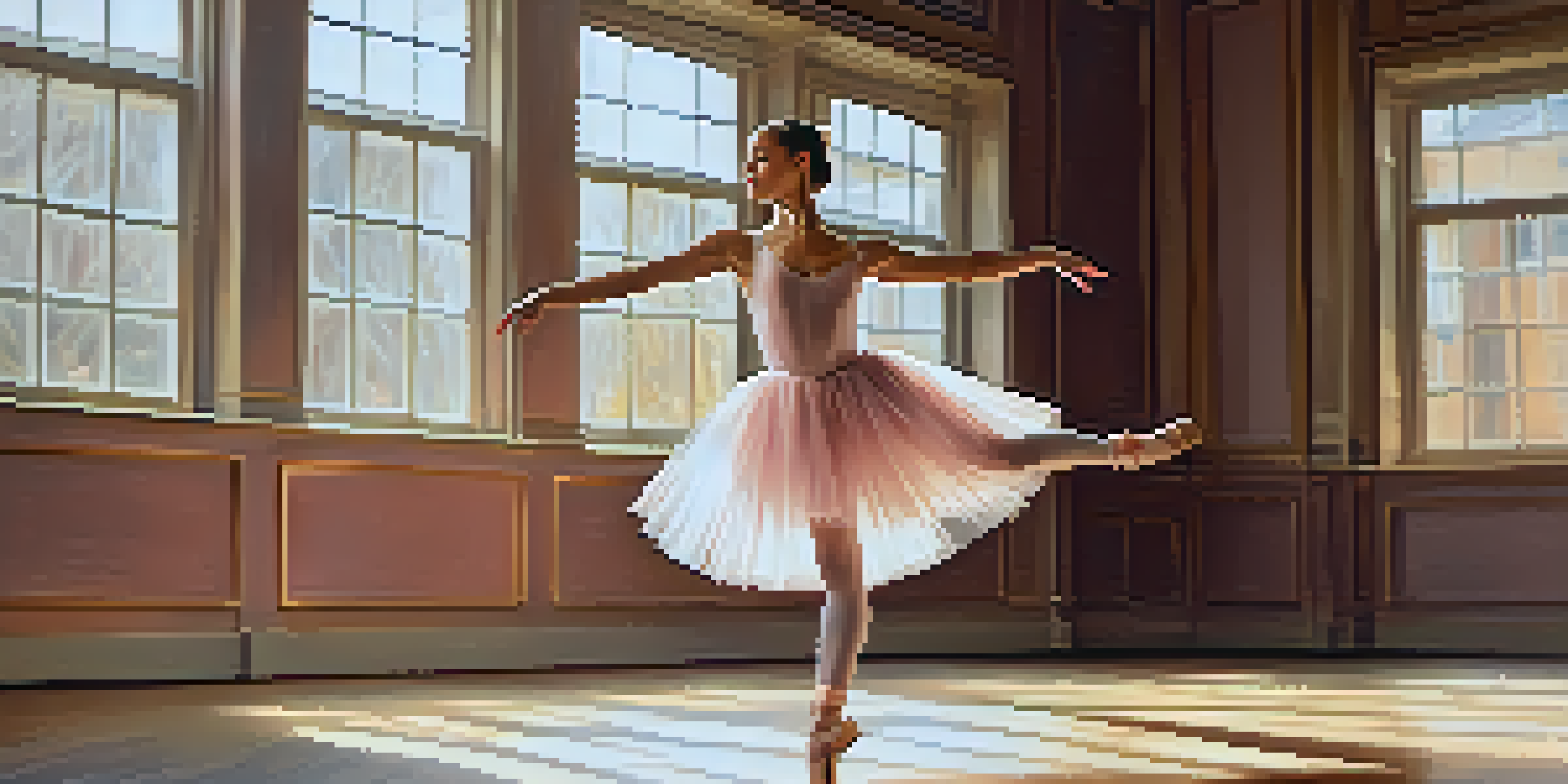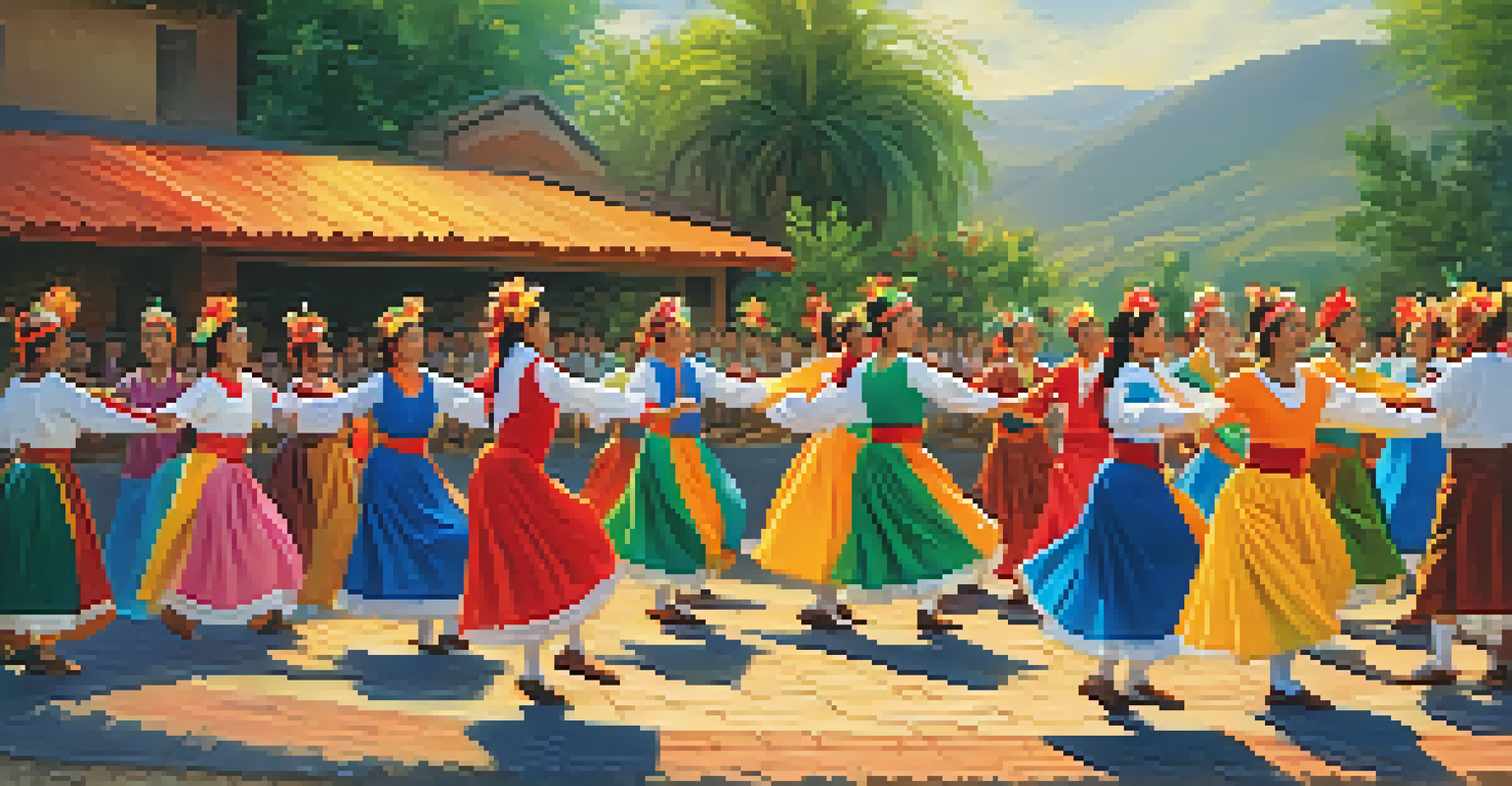Exploring Dance as a Unique Form of Non-Verbal Communication

Understanding Dance as a Language Beyond Words
Dance serves as a powerful form of communication that transcends spoken language. Through movement, dancers express emotions, narratives, and concepts that words often fail to convey. Just as different dialects exist in spoken languages, various dance styles—like ballet, hip-hop, and salsa—offer distinct ways of sharing feelings and stories.
Dance is the hidden language of the soul.
Consider how a dancer's body movements can evoke joy, sorrow, or tension, much like a heartfelt conversation without uttering a single word. This non-verbal dialogue allows for a deeper connection, as audiences can interpret and relate to the emotions being expressed. The beauty of dance lies in its ability to foster understanding across cultural and linguistic barriers.
In essence, dance becomes a universal language, inviting everyone to feel and connect without needing to understand the intricacies of spoken dialogue. This shared experience not only enriches personal connections but also enhances cultural appreciation, making dance a vital form of expression in our diverse world.
How Body Language Enhances Dance Communication
Body language plays a crucial role in dance, informing how movements are perceived by others. Every gesture, posture, and facial expression contributes to the overall message a dancer conveys. For instance, a raised arm may signify triumph, while a bent posture could evoke vulnerability, allowing viewers to interpret the emotional context behind the movements.

Moreover, the subtleties of body language can often communicate more than words ever could. Think of how a dancer's slight tilt of the head or a gentle sway can express longing or affection, creating an intimate connection with the audience. These non-verbal cues enrich the storytelling aspect of dance, drawing viewers into the emotional landscape being portrayed.
Dance as Universal Communication
Dance transcends spoken language, allowing for emotional and narrative expression that connects people across cultural barriers.
Ultimately, understanding body language in dance enhances the viewer's experience, allowing them to engage with the performance on a more profound level. As audiences become attuned to these cues, they can appreciate the intricate layers of meaning behind each movement, leading to a more immersive exploration of the dancer's expression.
Cultural Context: Dance as a Reflection of Society
Dance often reflects the values, traditions, and emotions of a culture, serving as a historical record of societal changes. Different cultures use dance to celebrate milestones, express grief, or convey social messages, making it a rich tapestry of human experience. For example, traditional folk dances often tell stories of community life, while contemporary styles may challenge societal norms.
The body says what words cannot.
By observing various dance forms, one can gain insights into the cultural context from which they emerge. A powerful performance may highlight social issues, such as inequality or identity struggles, using movement as a tool for awareness and change. This enables dance to act not only as art but also as a platform for dialogue about important societal themes.
In this way, dance becomes a vessel for cultural expression, allowing individuals to share their heritage and experiences with the world. Engaging with these diverse dance forms fosters a deeper understanding of different cultures, promoting empathy and appreciation for the rich variety of human expression.
The Emotional Power of Dance: A Shared Experience
The emotional impact of dance is profound, as it resonates deeply with both performers and audiences alike. When dancers pour their emotions into their movements, it creates an energy that can be felt throughout the space. This shared emotional experience allows audiences to connect with the performance on a personal level, often evoking their own memories and feelings.
Think about attending a dance performance where the atmosphere is charged with emotion; you may find yourself moved to tears or filled with joy. This connection is a testament to dance's ability to tap into universal human emotions, creating a sense of community among spectators. It’s as if we’re all sharing in the dancer's journey, feeling their triumphs and sorrows together.
Emotional Connection Through Dance
The shared emotional experience of dance creates a bond between performers and audiences, reflecting our collective humanity.
Furthermore, this emotional exchange fosters a unique bond between the dancer and the audience, turning a performance into a collective experience. In many ways, dance becomes a mirror reflecting our shared humanity, reminding us that we are not alone in our emotions, and that our stories are interwoven through the art of movement.
Dance Therapy: Healing Through Movement
Dance therapy is an innovative approach that harnesses the expressive power of movement to promote emotional and mental well-being. By encouraging individuals to express their feelings through dance, this therapeutic practice helps them process emotions, reduce stress, and improve self-esteem. It’s fascinating how movement can unlock parts of ourselves that words often cannot reach.
For instance, someone dealing with trauma may find it easier to express their feelings through dance, allowing them to release pent-up emotions and find healing. The freedom of movement in dance therapy provides a safe space for self-exploration, helping individuals reconnect with their bodies and emotions. This process can be incredibly liberating, fostering a sense of empowerment and self-awareness.
Ultimately, dance therapy exemplifies the therapeutic potential of non-verbal communication. It underscores how dance can be a healing tool, helping individuals navigate their emotional landscapes and find solace in the rhythm of movement, reinforcing the idea that dance is much more than just an art form—it's a pathway to healing.
The Role of Rhythm and Music in Dance Communication
Rhythm and music are integral to the art of dance, enhancing the emotional and communicative aspects of movement. The beat of a song can dictate the pace and style of the dance, guiding the dancer's movements and expressions. For example, a fast-paced rhythm may inspire energetic and lively movements, while a slow melody might evoke grace and fluidity.
Music often serves as a backdrop for the emotional narrative being conveyed in dance. The combination of movement and sound creates a multi-sensory experience, allowing audiences to engage with the performance on various levels. This interplay between rhythm and dance not only enriches the storytelling but also deepens the emotional impact of the performance.
Dance Therapy's Healing Potential
Dance therapy harnesses movement to promote emotional well-being, offering a unique pathway for self-expression and healing.
As dancers sync their movements to the music, they create a harmonious dialogue that captivates the audience. This relationship between rhythm and dance underscores the importance of sound in enhancing non-verbal communication, illustrating how music can elevate the expressive potential of movement, making it a more powerful form of storytelling.
The Future of Dance as Non-Verbal Communication
As we move forward in a rapidly changing world, the role of dance as a form of non-verbal communication continues to evolve. With the rise of technology and digital platforms, dance is now more accessible than ever, allowing diverse voices to share their stories through movement. This democratization of dance opens new avenues for expression and connection across global communities.
Emerging styles and fusion genres are also redefining what dance can communicate, blending cultural influences and pushing creative boundaries. This evolution not only enriches the dance landscape but also encourages collaboration and innovation, resulting in fresh interpretations of traditional forms. As artists experiment with new ideas, they contribute to the ongoing dialogue about identity, culture, and emotion.

Looking ahead, dance will undoubtedly remain a vital means of non-verbal communication, continuing to inspire and connect people across different backgrounds. Embracing this dynamic art form allows us to celebrate our shared humanity while also exploring the unique stories that each dancer has to tell, ensuring that the language of dance remains vibrant and relevant for generations to come.